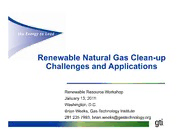
DTIC ADA558472: Renewable Natural Gas Clean-up Challenges and Applications PDF
Preview DTIC ADA558472: Renewable Natural Gas Clean-up Challenges and Applications
Renewable Natural Gas Clean-upp Challenges and Applications Renewable Resource Workshop January 13, 2011 Washington, D.C. Brian Weeks, Gas Technologgyy Institute 281 235 7993, [email protected] Report Documentation Page Form Approved OMB No. 0704-0188 Public reporting burden for the collection of information is estimated to average 1 hour per response, including the time for reviewing instructions, searching existing data sources, gathering and maintaining the data needed, and completing and reviewing the collection of information. Send comments regarding this burden estimate or any other aspect of this collection of information, including suggestions for reducing this burden, to Washington Headquarters Services, Directorate for Information Operations and Reports, 1215 Jefferson Davis Highway, Suite 1204, Arlington VA 22202-4302. Respondents should be aware that notwithstanding any other provision of law, no person shall be subject to a penalty for failing to comply with a collection of information if it does not display a currently valid OMB control number. 1. REPORT DATE 3. DATES COVERED 13 JAN 2011 2. REPORT TYPE 00-00-2011 to 00-00-2011 4. TITLE AND SUBTITLE 5a. CONTRACT NUMBER Renewable Natural Gas Clean-up Challenges and Applications 5b. GRANT NUMBER 5c. PROGRAM ELEMENT NUMBER 6. AUTHOR(S) 5d. PROJECT NUMBER 5e. TASK NUMBER 5f. WORK UNIT NUMBER 7. PERFORMING ORGANIZATION NAME(S) AND ADDRESS(ES) 8. PERFORMING ORGANIZATION Gas Technology Institute (GTI),1700 S. Mount Prospect Rd,Des REPORT NUMBER Plaines,IL,60018 9. SPONSORING/MONITORING AGENCY NAME(S) AND ADDRESS(ES) 10. SPONSOR/MONITOR’S ACRONYM(S) 11. SPONSOR/MONITOR’S REPORT NUMBER(S) 12. DISTRIBUTION/AVAILABILITY STATEMENT Approved for public release; distribution unlimited 13. SUPPLEMENTARY NOTES presented at the DOE-DOD Waste-to-Energy using Fuel Cells Workshop held Jan. 13, 2011 in Washington DC. U.S. Government or Federal Rights License 14. ABSTRACT 15. SUBJECT TERMS 16. SECURITY CLASSIFICATION OF: 17. LIMITATION OF 18. NUMBER 19a. NAME OF ABSTRACT OF PAGES RESPONSIBLE PERSON a. REPORT b. ABSTRACT c. THIS PAGE Same as 24 unclassified unclassified unclassified Report (SAR) Standard Form 298 (Rev. 8-98) Prescribed by ANSI Std Z39-18 TTooddaayy’ ss TTaallkk >WWhhoo iiss GGTTII >What is Renewable Natural Gas (RNG) >CChhallll enges ff or RR enewabblle NNatt urall GGa s >How do we clean up RNG? >Recommendations and Summary 22 GTI at a Glance… >> NNoott --ffoorr --pprrooffiitt rreesseeaarrcchh, with 65+ year history > Facilities ─ 1188 acre campus near CChhiicago ─ 200,000 ft2, 28 specialized labs > $$6600 + miilllliio n iin revenue > Staff of 250 Flex-Fuel Test > A ggrowingg business Offices FFaacciilliittyy && Labs > Commercial partners take our technologies to market Energy & Environmental Technology Center 33 Gas Quality and RNG Clean-up A Sustainable Gas Network Will Include Renewable Sources Gas Distributors increasingly asked ttoo aacccceepptt rreenneewwaabbllee ggaass. Pipeline tariffs generally don’t address “trace” constituents. Existing clean-up methods are generally intended for on-site use. Little data on impact of constituents on pipelines or end use equipment Gas quality research also important for unconventional shale gas supplies. NNaattiioonnaall GGrriidd, RReenneew aabbllee GGaa ss, ““VViissiioonn ff oorr aa sustainable gas network”, 2010 4 RReenneewwaabbllee NNaattuurraall GGaass iiss…… > Methane pproduced from diggesters ─ Animal manure (dairy cows, swine) ─ WWaassttee wwaatteerr ttrreeaattmmeenntt ffaacciilliittiieess > Methane from Landfills >> RRNNGG pprroodduucceedd ffrroomm tthheerrmmaall cchheemmiiccaall pprroocceesssseess lliikkee gasification utilizing renewable feed-stocks including forest residues and agricultural wastes. RENEWABLE NATURAL GAS CAN BE CLEANED- UP AND PLACED IN THE NATURAL GAS PIPELINE SYSTEM 55 GTI RNG Projject Exampples >Example GTI Projects: ─Gills Onions —Anaerobic digestion of agricultural waste for on-site electricity generation ─Altamont Landfill —Landfill gas (LFG) cleanup for production of liquefied natural gas (LNG) for vehicle fuel ─Ft. Lewis —Anaerobic digestion of waste water for production of hydrogen as a fuel cell vehicle fuel ─SCRA * – Landfill gas (LFG) cleanup and on-site reformation to generate hydrogen for MHE in S.C. *Project pending final authorization 66 Difference between “Conventional GGas andd ““RR enewabbll e NNatt urall GG as”” >CCoonnvveennttiioonnaall ggaass iiss 9955%% - 9988%% mmeetthhaannee ((CCHH )) * 44 ─ Constituents are well understood ─ Utilityy ppippeline tariffs ac count for tyyppical and Interstate components ─ Methods for treating “raw” gas are proven and in-place >RNG is also 95% - 98% methane* ─ Constituents are not as well understood ─ Utility and Interstate pipeline tariffs don’t typically address all components ─ MMeetthhooddss ffoorr ttrreeaattiinngg “rraaww ” bbiiooggaass ccaann bbee ccoossttllyy *Post clean-up. Methane percentage could be lower in some cases 77 Existing Technologies Can and Do remove ttrace consttiitt uentt s ffrom RRNNGG > CO & O found at % to ppm level concentrations. Tariff 2 2 lliim iitts tty piic all 11- 22%% ((CCOO && 00.22%% OO 2 2 > Sulfur Compounds (H S). Typical tariff is 0.25 grain/100SCF 2 ffoorr HH SS aanndd 11 ggrraaiinn//110000ssccff ttoottaall ssuullffuurr 22 > Inerts (N , He ) and H 2 2 > Halocarbon comppounds > Volatile Organics (BTEX, aldehydes, ketones) > Ammonia / Amines > Siloxanes > Mercury and Other Elementals > Bacteria and MIC 88 Focus Areas for Improvement RRenewabbll e NNatturall GG as UUttiillii zattii on >Supppplyy Stabilityy: Variabilityy in compposition & supppp lyy >Impact on Infrastructure / Pipeline integrity: CO , 2 water, H sulfur compounds, NH bacteria, etc. 22 33 >Impact on end use applications: ─ CO2, CO, H2 > flame stability, engine knock, >Safety – Odorization & leak detection >Contaminant Dispposal – Cleanupp media ggenerallyy not recyclable >Little Analysis has been performed on biogas for fuel cell applications 99
